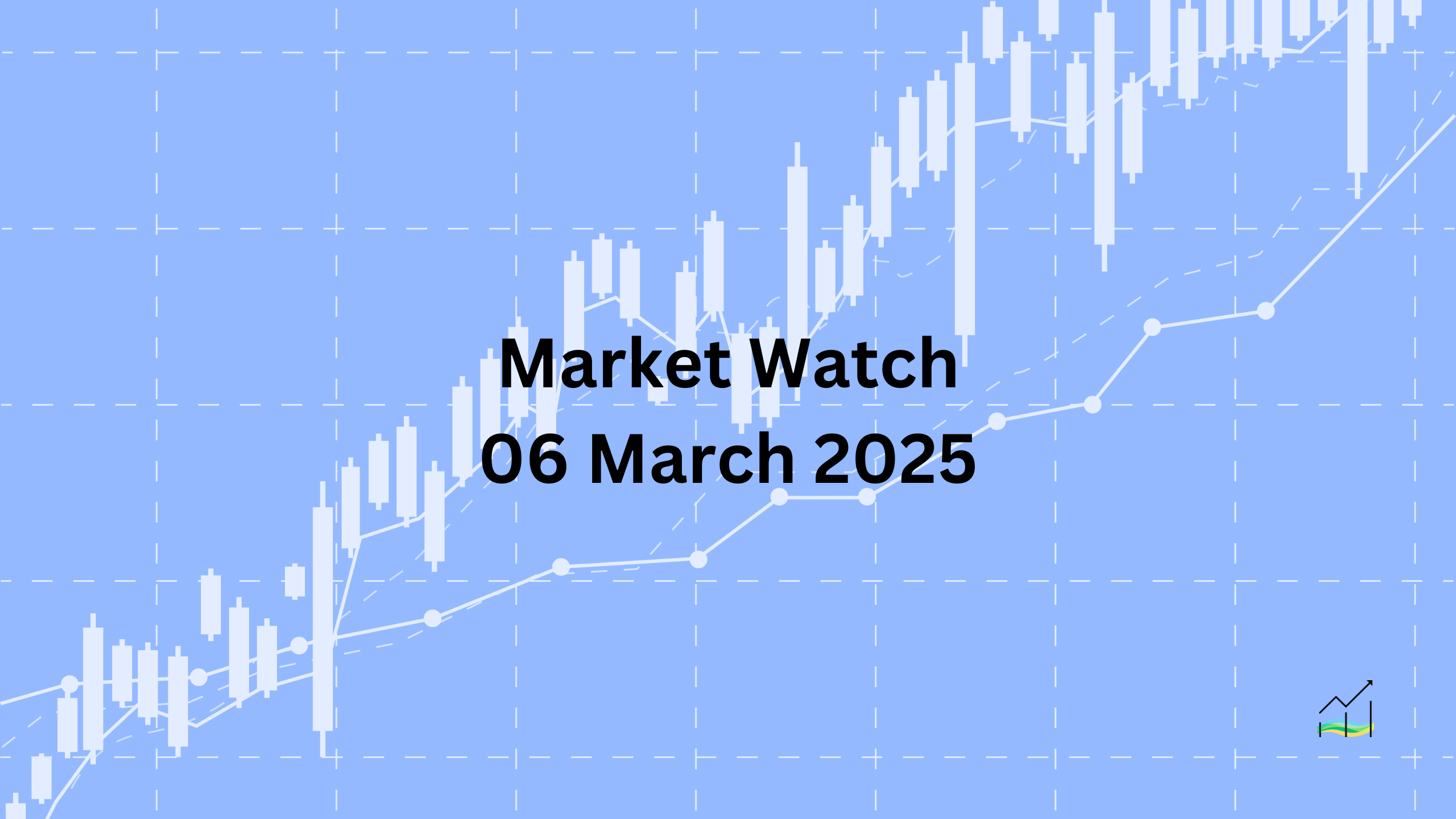06/03/2025 Market Watch

Dollar's Momentum Pauses Ahead of Key ECB Decision
The US dollar continued its recent surge today but began to lose momentum as European trading got underway. Despite this, currencies like the Australian and Canadian dollars, along with the British pound, are trading lower as North American traders enter the market. Most emerging market currencies are also facing downward pressure.
Today’s central focus is on the European Central Bank (ECB) meeting, where the market widely anticipates another quarter-point reduction in interest rates, bringing the benchmark rate down to 2.50%. Investors are particularly keen to hear guidance on the ECB’s next moves, with expectations suggesting a possible pause next month followed by another cut in June.
Meanwhile, European bond markets continue to experience significant selling pressure, causing yields to spike. Benchmark 10-year bond yields across the Eurozone rose by another 6-8 basis points today and have climbed around 45 basis points over the past five trading days. This contrasts sharply with a modest 4-basis-point increase in the US 10-year Treasury yield, which currently stands near 4.3%.
European Union leaders are gathering today for a summit, where discussions will likely solidify plans for relaxed fiscal policies, particularly targeting defense and security spending.
Equities are mixed globally. Asia-Pacific markets generally advanced, with notable gains in Taiwan and Australia. However, Europe’s Stoxx 600 index has fallen roughly 0.6% today after yesterday's strong gains. In the US, market sentiment appears negative, as futures indicate sharp declines—Nasdaq futures are down over 1%, and S&P 500 futures have dipped around 0.8%.
Commodity markets are also seeing mixed performance. Gold prices have softened, currently trading near $2,900 after closing around $2,019 yesterday. Oil markets stabilized slightly after yesterday’s sharp drop, with April WTI crude oil holding above $66 per barrel, having touched a six-month low near $65.20 previously.
United States of America
Overview
The US Dollar Index, after rising sharply by 1.2% over three consecutive days, reversed its gains on Monday and has continued to decline today. Currently, it's down around 3.4% from its recent highs, falling below the key 200-day moving average near 105.00 for the first time since last November. It has tested important support around 104.00, a key retracement level from its rally that began last September. If this level breaks decisively, the next notable support could be near 103.35.
Investors today are navigating several economic data releases, positioned between ongoing tariff concerns and Friday’s important US employment report.
Economic Drivers
Today's primary economic driver is the US trade balance report for January. Previously released data already indicated that the US goods deficit surged significantly—by around 25%—reaching a record high of $153.3 billion. Although the US typically maintains a small surplus in services, the overall trade deficit likely widened dramatically, potentially reaching nearly $129 billion from about $98.5 billion in December. This sharp increase may partly be due to businesses increasing imports ahead of anticipated tariff hikes, creating a temporary distortion.
Wholesale inventories rose modestly by 0.7%, the largest increase since August 2022. However, even this rise, valued at approximately $1 billion, provides little offset to the negative impact of the widened trade deficit on economic growth.
Data and Events
Several economic releases today attracted attention, although some had limited market relevance. The Q4 productivity and unit labor cost data were largely viewed as outdated, holding more importance for economists than traders. Similarly, weekly jobless claims data were overshadowed by tomorrow’s closely-watched US employment report.
However, today's ADP private sector jobs report drew some notice. Job growth came in at just 77,000—half the expected figure and the weakest since July of last year. This subdued employment number could signal potential weakness ahead of tomorrow’s official employment data, but it’s still too early to gauge a significant market reaction.
Price Action
In price action, the Dollar Index’s sharp reversal below the crucial 200-day moving average at approximately 105.00 is significant from a technical perspective. Today’s test of the 104.00 level, a key Fibonacci retracement point (61.8%), is a critical moment. Traders will watch closely whether this support holds. If not, expect further downside moves toward the next important technical support around 103.35.
Key Points:
- Dollar Index reversed sharply, now down around 3.4%, below key 200-day moving average near 105.00.
- Important technical support tested near 104.00, with next target at 103.35 if breached.
- US goods deficit reached a record high ($153.3 billion), pushing overall deficit towards nearly $129 billion.
- Weak ADP employment data (77k vs. expected double) signals caution ahead of Friday’s jobs report.
- Rise in wholesale inventories (0.7%) modestly offsets widened trade deficit, but impact limited.
Australia
Overview
The Australian dollar experienced a strong recovery earlier this week, posting a bullish reversal on Tuesday, and extending gains into Wednesday, briefly surpassing the $0.6340 level. However, momentum has faded today, with the Aussie retreating toward session lows near $0.6325. Immediate support is now around the $0.6300 level.
Australia’s trade surplus has shrunk notably over the past year, reflecting shifts in export and import trends and impacting the overall current account balance.
Economic Drivers
A significant driver of the Australian dollar's movement today comes from trade data released earlier. Australia's trade surplus in January declined sharply to A$5.6 billion from A$9.23 billion reported a year earlier. This highlights weakening export strength compared to rising imports, which impacts Australia's overall economic outlook.
For the full year of 2024, Australia's goods surplus stood at A$68.7 billion, significantly lower than the A$124.6 billion surplus recorded in 2023. This narrowing surplus is attributed to a 2.5% decline in exports and a nearly 10% increase in imports throughout last year.
Australia's current account deficit for 2024 is expected to widen to around 2% of GDP—the highest since 2018. This indicates increasing external economic vulnerability and highlights Australia's dependence on trade conditions, particularly with its key trading partner, China.
Data and Events
January trade data released today showed exports rebounded slightly by 1.3% month-over-month, while imports decreased marginally by 0.3%. Despite January's modest improvement in exports, the broader trend from last year remains a cause for concern, suggesting continued pressure on Australia’s trade balance.
It is important to note Australia's heavy trade reliance on China. Australia's trade volume with China alone exceeds its combined trade with the next three largest partners: Japan, the US, and South Korea. Therefore, economic conditions and demand from China remain critical to Australia's trade health and currency outlook.
Price Action
From a technical standpoint, the Australian dollar recently showed bullish momentum, briefly touching near $0.6360 today before pulling back towards session lows around $0.6325. Short-term support is established at around $0.6300, making this a critical area to watch. Traders should monitor whether the Aussie can sustain this level or risks further decline.
Key Points:
- The Australian dollar strengthened this week, briefly surpassing $0.6340, but currently retreating toward $0.6325.
- Immediate technical support identified near $0.6300.
- Australia's January trade surplus significantly narrowed to A$5.6 billion from A$9.23 billion year-over-year.
- Annual surplus for 2024 fell sharply to A$68.7 billion (down from A$124.6 billion in 2023).
- Exports declined 2.5% and imports increased nearly 10% in 2024, widening the current account deficit to approximately 2% of GDP.
- Australia remains heavily reliant on trade with China, surpassing combined trade with Japan, the US, and South Korea.
Canada
Overview
The Canadian dollar found some relief yesterday following comments from the US Commerce Secretary that hinted at a potential easing of trade tariffs. This optimism helped the currency recover some recent losses. However, the currency pair remains volatile as markets weigh trade uncertainties against economic data.
Economic Drivers
Canada’s trade balance and broader economic conditions continue to influence the currency significantly. In 2024, Canada consistently reported monthly goods trade deficits, except for three months, totaling C$7.2 billion for the year. While substantial, this deficit was significantly smaller—less than one-tenth of the deficit reported in 2023. Overall, Canada maintains a relatively modest current account deficit, averaging less than 0.4% of GDP over the past four years.
The potential easing of US tariffs is currently the major short-term economic driver supporting the Canadian dollar, but broader economic concerns remain, especially given the uncertainty around US-Canada trade relations.
Data and Events
Today’s key economic data includes Canada’s January goods trade balance and the IVEY Purchasing Managers' Index (PMI). The IVEY PMI had previously dropped significantly in January, falling to 47.10 from 54.70, reaching levels last seen during the pandemic. Markets anticipate further deterioration in the February data due to ongoing disruptions related to the US trade environment, highlighting potential vulnerabilities in Canada’s economic outlook.
Price Action
From a technical perspective, the USD/CAD exchange rate pulled back sharply to nearly CAD1.4330 yesterday, reversing roughly half of the gains made since mid-February’s lows near CAD1.4150. Today, the pair briefly approached CAD1.4300 before bouncing back towards CAD1.4360. Traders should closely monitor resistance levels near CAD1.4400-1.4420, as these areas may cap further upward movement.
Key Points:
- Canadian dollar strengthened following optimism over potential US tariff relief.
- USD/CAD retreated to around CAD1.4330 yesterday, recovering today to approximately CAD1.4360.
- Resistance seen around CAD1.4400-1.4420.
- Canada's 2024 annual trade deficit significantly improved to C$7.2 billion, dramatically smaller than in 2023.
- IVEY PMI likely deteriorated further in February, influenced by US economic disruptions.
- Canada maintains a small current account deficit averaging less than 0.4% of GDP.
China
Overview
The US dollar started this week by climbing close to CNH7.30 against the Chinese yuan. However, the broad retreat of the dollar allowed the yuan to strengthen slightly, with the USD/CNH pair briefly dipping below CNH7.2335 yesterday. This marked a close approach to February’s low of around CNH7.2290—the yuan’s strongest level since late last November. Despite this short-term easing, the dollar has regained strength today, trading back above CNH7.25.
Ongoing trade tensions between the US and China continue to overshadow the market, as tariff pressures rise, yet diplomatic engagement remains minimal.
Economic Drivers
The key driver of recent movements in the USD/CNH exchange rate remains the US-China trade relationship. Over the past two months, the US has significantly raised tariffs on Chinese goods—up by 20%—and appears committed to further increases. China's reaction, however, has been notably measured. Beijing has responded cautiously, implementing mild retaliatory measures rather than matching the US escalation. This restrained approach suggests China's intention to maintain the possibility of a diplomatic resolution rather than escalating further economic harm.
Diplomatic communication between the two countries has been notably absent. Since the US presidential inauguration on January 20, no direct conversation between President Trump and President Xi Jinping has been reported. Additionally, the US has not clearly indicated a pathway to de-escalation, leaving market uncertainty intact.
Data and Events
Today's key data point came from the People's Bank of China (PBOC), which set the official reference rate for the yuan at CNY7.1692 per dollar. This represents the third consecutive day of a lower yuan fixing and is the lowest official reference point in about a month. The PBOC’s decision reflects a careful balance between responding to market pressures and avoiding further sharp depreciation.
Price Action
In terms of price action, the USD/CNH pair recently demonstrated notable volatility. After nearly reaching CNH7.30 at the week's open, the pair dipped below CNH7.2335 yesterday, approaching February’s significant low (CNH7.2290). The dollar’s rebound today, however, pushed the pair firmly above CNH7.25. Traders should monitor the CNH7.2290 support level closely, as a breach could signal further yuan strength. Conversely, continued strength above CNH7.25 may open a renewed move back toward CNH7.30.
Key Points:
- The dollar briefly weakened against the yuan, dipping near monthly lows around CNH7.2290, but has since rebounded above CNH7.25.
- US-China trade tensions persist, with US tariffs up by 20% in two months, and potential further increases looming.
- Beijing has maintained a restrained response, leaving room for diplomatic solutions.
- Trump and Xi have reportedly not communicated directly since the US inauguration on January 20.
- The PBOC set the yuan’s reference rate at CNY7.1692, marking its lowest point in a month.
- Crucial support at CNH7.2290 remains important for near-term yuan direction.
Europe
Overview
The euro experienced significant upward momentum this week, driven primarily by Europe's increased defense spending, rising long-term interest rates, and growing concerns about economic growth in the United States. Having ended last week below $1.04, the euro advanced notably to nearly $1.08 yesterday and briefly touched above $1.0820 today before stabilizing around this level.
The market now awaits today's crucial European Central Bank (ECB) meeting, where a further rate cut and updated economic forecasts are expected to set the tone for future euro movements.
Economic Drivers
The primary factors supporting the euro’s rally include Europe's expanded fiscal stance, particularly increased defense and security spending, and the sharp rise in European long-term bond yields. Additionally, concerns about the pace of US economic growth have weakened the US dollar, indirectly boosting the euro.
However, several uncertainties remain. The potential escalation of US tariffs, the unresolved geopolitical tensions surrounding Ukraine, and fluctuations in commodity prices, particularly Brent oil, could impact the euro’s outlook. Brent crude prices have declined roughly 5.5% since the ECB’s last meeting, potentially influencing inflation forecasts.
Data and Events
The ECB is widely anticipated to deliver another quarter-point rate cut at today’s meeting. Beyond the immediate decision, markets are keenly focused on two key channels of ECB communication:
- ECB President Christine Lagarde’s press conference: Lagarde will likely emphasize flexibility amid economic uncertainty, balancing acknowledgment of recent progress with caution about ongoing challenges, including potential implications of increased European defense spending.
- ECB Staff Forecasts: Updated economic forecasts will be crucial. Previously in December, GDP growth forecasts were set at 1.1% for 2025, 1.4% for 2026, and 1.3% for 2027. Inflation (CPI) forecasts were at 2.1%, 1.9%, and 2.1% respectively for these years. Since then, the euro has strengthened significantly, oil prices have fallen, and tariff threats from the US have increased, potentially prompting revisions in these forecasts.
Price Action
From a technical perspective, the euro’s rally brought it to a key retracement level near $1.08, representing approximately 61.8% of its recent decline from last September's high of around $1.1215. If the euro convincingly breaks above the current area, the next significant resistance is around the US election-day high near $1.0935. This makes the current $1.08 level crucial for traders in the near term.
Key Points:
- Euro strengthened significantly this week, rising from below $1.04 to briefly above $1.0820.
- ECB meeting today widely expected to deliver another 0.25% rate cut.
- Market closely watching ECB’s updated economic forecasts and Lagarde’s comments.
- Increased European defense spending and rising long-term rates support the euro, amid US growth concerns.
- Euro faces technical resistance at current $1.08 area; next major resistance near $1.0935.
- Brent crude oil price down approximately 5.5% since December forecasts; tariff threats and geopolitical uncertainty remain ongoing risks.
Japan
Overview
The US dollar weakened significantly against the Japanese yen following disappointing US employment data, driving it to its lowest level since last October. Despite a temporary recovery in US bond yields, the dollar struggled to regain strength against the yen, highlighting persistent investor caution amid economic uncertainties.
Economic Drivers
The primary driver behind the dollar's weakness against the yen was a sharp decline in US 10-year Treasury yields, triggered by weaker-than-expected ADP private-sector employment figures. This suggests potential softness in the broader US labor market, prompting investors to reconsider their outlook for US economic growth and interest rates.
Additionally, investor portfolio flows between the US and Japan remain influential. Data indicates increased foreign interest in Japanese government bonds this year—foreign investors have bought more than four times as many bonds compared to early 2024. Conversely, foreign investors shifted to selling Japanese equities, reversing last year's trend. Meanwhile, Japanese investors maintained steady foreign bond purchases and slightly reduced equity investments abroad.
Data and Events
Key economic data today included the ADP employment report, which showed private-sector job growth significantly below expectations. This disappointing result triggered a sharp drop in Treasury yields, weakening the dollar.
Japan’s Ministry of Finance also released its weekly portfolio flow report covering late February. This report highlighted key shifts in investor behavior, particularly the notable increase in foreign investors purchasing Japanese bonds, signaling confidence in Japan's stability compared to the US economic outlook.
Price Action
The USD/JPY exchange rate saw sharp volatility following the ADP jobs data. Before the release, the dollar traded around JPY149.70, quickly dropping to session lows near JPY148.40 immediately afterward. Despite Treasury yields bouncing back to about 4.28%, the USD/JPY pair could barely recover above JPY149. The dollar subsequently slipped further, trading near JPY147.70, marking its weakest level since last October.
From a technical viewpoint, traders should watch the critical JPY147.00 area, a significant retracement level (61.8%) of the rally from September’s lows to early January highs. This area may provide short-term support, potentially determining whether further declines follow.
Key Points:
- US dollar fell sharply against the yen, reaching multi-month lows (~JPY147.70), after weak ADP employment data.
- US 10-year Treasury yields briefly fell but later rebounded; the dollar still struggled to recover.
- Foreign investors sharply increased Japanese bond purchases while shifting to selling Japanese equities.
- Japanese investors maintain stable foreign bond purchases but slightly reduced equity investments overseas.
- Technical support for USD/JPY closely watched around the critical JPY147.00 retracement level.
United Kingdom
Overview
Sterling saw notable gains this week, rising above its key 200-day moving average at around $1.2785 for the first time since mid-November. Despite pushing as high as $1.2925 today, its momentum has slowed in the European session, highlighting uncertainty about the UK economy's growth outlook. With few immediate economic catalysts ahead, the market remains cautious.
Economic Drivers
The main economic factor limiting sterling’s potential gains is persistent weakness in the UK's growth outlook. The UK economy has remained stagnant since the second half of 2024, showing minimal signs of improvement. This sluggish environment dampens investor confidence and restrains further gains for sterling.
Additionally, concerns about the UK's construction sector, a significant contributor to economic activity, have intensified. Construction data continues to indicate contraction, adding pressure to overall economic sentiment.
Data and Events
Recent economic data highlighted weakness in the UK construction industry, with the Construction Purchasing Managers' Index (PMI) dropping below the critical 50-level in January (indicating contraction) for the first time since February 2024. It further declined sharply to 44.6 last month—the lowest reading since late 2023.
The absence of major economic releases until next Friday’s GDP report means the market will remain sensitive to global developments rather than domestic economic news in the short term. Next week's January GDP data will be closely watched for clearer signals on economic momentum.
Price Action
Sterling experienced solid buying momentum early in the week, successfully rising above its crucial technical level—the 200-day moving average (~$1.2785). The rally reached as high as $1.2925, aligning with the key 61.8% retracement of sterling's decline since last September. However, gains stalled during today's European session, pulling sterling back to around $1.2870. Immediate support is now near $1.2850, while significant resistance awaits around the $1.3000-$1.3030 zone.
Key Points:
- Sterling rose above the 200-day moving average (~$1.2785) for the first time since November.
- Gains reached as high as $1.2925, coinciding with a key technical retracement (61.8%).
- Immediate support near $1.2850; resistance around $1.3000-$1.3030.
- UK construction PMI fell sharply to 44.6, indicating significant sector contraction.
- UK economic growth remains stagnant, limiting sterling’s upside potential.
- Next major economic data (January GDP) due next Friday.
© 2025 SKONE Enterprise (003319453-V). All rights reserved.
The content on this site is for informational purposes only and does not constitute financial advice.


